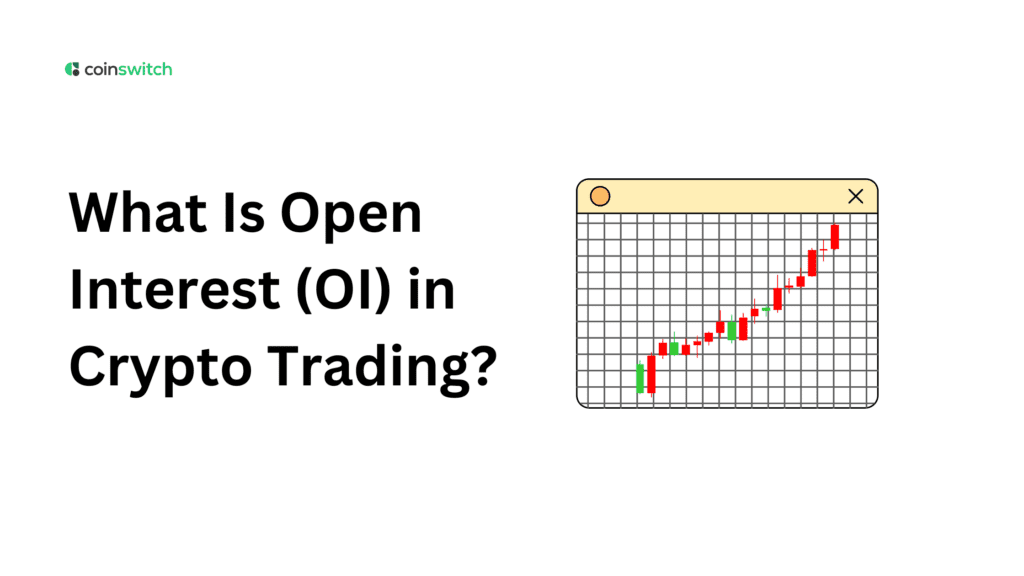What Is Open Interest?
Open Interest (OI) represents the total number of open futures or options contracts that are still active in the market. These contracts haven’t been settled, expired, or closed yet. When new traders enter the market and open fresh positions, open interest rises. When existing traders close their positions, it falls. High OI means a lot of participation and liquidity. Low OI means traders are exiting or staying cautious. So, if price is the direction of the market and volume shows its speed, OI reveals the commitment behind the move. That’s why traders often track it daily.
Understanding Open Interest
In crypto, OI gives you a live snapshot of market activity in derivatives, mainly futures and options. It doesn’t tell you who’s winning or losing, but it shows how much capital is currently at risk.
Here’s how it works:
- Every time a new buyer and a new seller open a position, OI increases.
- When both parties close positions, OI decreases.
- If one exits while another enters, OI stays the same.
Imagine Bitcoin is trading at ₹1,08,00,000, and total open interest in BTC futures stands at ₹24,000 crore. That number represents how much notional exposure is currently live across all exchanges. If that OI jumps to ₹30,000 crore next week, it means new traders are joining, adding liquidity and energy to the market.
On the other hand, if OI drops back to ₹18,000 crore while prices keep rising, it suggests traders are taking profits or closing shorts, not new capital driving the move.
Read More: Crypto Borrowing: How to Get Liquidity Without Selling Your Crypto
What is OI in crypto trading?
In crypto trading, OI stands for Open Interest, which is the total number of active, outstanding futures and options contracts that have not yet been settled or closed. Simply put, it shows how much money or interest is currently in the market for a particular derivative, providing insight into market sentiment, liquidity, and the strength of a price trend.
The Role of Open Interest in Market Trends
Open interest acts as a confidence barometer. It tells you whether the current move has muscle behind it or if it’s just short covering or panic buying.
Here’s how traders usually read it:
- Price Up + OI Up → Strong Bullish Trend
New buyers are entering the market and opening fresh long positions. The rally is backed by real capital inflow. - Price Down + OI Up → Strong Bearish Trend
Sellers are adding new shorts. The trend is healthy on the downside and may extend further. - Price Up + OI Down → Short Covering
Shorts are exiting their trades, causing prices to rise temporarily. These rallies usually cool off fast. - Price Down + OI Down → Long Liquidation
Longs are exiting positions after losses. It shows weakening conviction and risk aversion.
When Bitcoin hovers near ₹1,08,00,000 and open interest grows, it shows conviction from both sides. But if OI drops sharply, traders are backing off, meaning fewer participants are willing to hold through volatility.
OI doesn’t predict price. It reveals the strength of sentiment.
Open Interest vs. Trading Volume
Traders often mix up open interest with volume, but they measure very different things.
- Trading Volume shows how many contracts changed hands during a given period.
- Open Interest shows how many contracts remain open after that period ends.
Example:
If 500 traders open new Bitcoin futures contracts, OI rises by 500.
If those 500 contracts are traded back and forth 10,000 times in a day, the volume is 10,000, but OI remains 500.
Volume resets daily. OI accumulates and updates in real time.
When you combine them, patterns appear:
- Rising volume + rising OI → a strong, sustainable trend.
- Rising volume + falling OI → traders are closing fast; trend may fade.
So, while volume shows short-term action, OI tells you whether the market still has fuel left.
Read More: What is NFT lending?
Importance
1. It Reveals Market Confidence
When OI rises during a rally, it shows traders are entering with conviction. Money is flowing in, liquidity is improving, and the trend stands on solid ground.
If Bitcoin breaks above ₹1,10,00,000 with both price and OI rising, it’s a strong signal that buyers are in control.
2. It Indicates Liquidity
Higher OI means more open contracts, tighter spreads, and lower slippage. That’s vital for institutional desks and large-volume traders. A deep OI environment means the market can absorb big trades without wild price swings.
3. It Warns of Liquidation Clusters
When OI spikes too fast, it can be dangerous. It often means over-leveraged traders are piling in. If prices move sharply the other way, mass liquidations can cascade, causing sudden crashes or short squeezes.
For example, if OI climbs by ₹5,000 crore within hours while Bitcoin stays around ₹1,08,00,000, it may indicate aggressive leverage, a setup that could flip into volatility fast.
4. It Shows Where Sentiment Shifts
Falling OI in an uptrend means traders are booking profits. Rising OI in a downtrend means short sellers are entering. It’s one of the cleanest sentiment signals in crypto, no noise, just contract counts.
5. It Confirms Breakouts
When Bitcoin breaks key levels with a jump in OI, that move is more likely to hold. If OI drops during a breakout, it might be false momentum driven by short covering.
Open interest acts like an X-ray, showing you how much real conviction exists behind the surface action.
Read More: What are Hedging Contracts: An Explainer
Example
Let’s say Bitcoin trades at ₹1,08,00,000 and total open interest across exchanges is ₹22,000 crore.
Now suppose, over three days, Bitcoin climbs to ₹1,12,00,000 and OI rises to ₹26,500 crore. That’s a healthy combination; both price and participation are growing. It suggests that traders are confident, building long positions, and expecting continuation.
But if Bitcoin rises to ₹1,12,00,000 and OI drops to ₹18,000 crore, that tells a different story. Shorts are closing, not new longs opening. It’s a short-covering rally, less durable, often followed by a correction.
The opposite scenario also matters. If Bitcoin drops from ₹1,08,00,000 to ₹1,04,00,000 while OI surges, it signals that fresh short positions are being built. The downtrend has energy behind it.
By tracking these shifts, traders can separate real momentum from noise.
Conclusion
Open interest is one of the clearest windows into crypto market sentiment. It doesn’t predict direction, but it confirms strength, conviction, and risk.
Understanding what OI is helps you see beyond price charts. It shows whether capital is entering or leaving, whether the trend is gaining power or losing steam.
When Bitcoin trades near ₹1,08,00,000, a steady rise in OI suggests confidence. A sudden drop warns of fading momentum. Combined with volume and funding data, it gives a complete picture of the market’s internal health.
Open interest’s meaning goes beyond numbers; it’s about understanding trader behavior. In a market driven by leverage and psychology, that insight can make all the difference.
For any serious crypto trader, OI isn’t just another metric. It’s the pulse of the derivatives market, steady, revealing, and always honest.
FAQs
1. What is open interest in OI analysis?
In OI analysis, open interest measures how many futures or options contracts remain open in the market. It tells you how much money is still active and how engaged traders are.
2. What is OI in crypto?
In crypto, OI shows participation in futures and options markets for coins like Bitcoin or Ethereum. High OI means heavy trading activity and strong liquidity. Low OI means fewer open positions and reduced volatility.
3. What is open interest with an example?
Suppose Bitcoin trades at ₹1,08,00,000, and there are 1,000 open futures contracts. If 200 traders close their positions, open interest drops to 800. That number represents how many active contracts still exist.
4. What happens when the call OI is high?
The interpretation of high call OI depends on several market factors. A high call open interest combined with a rising price can be a bullish signal. However, in a scenario where the price is stagnating or falling, a high OI can be a bearish signal.








